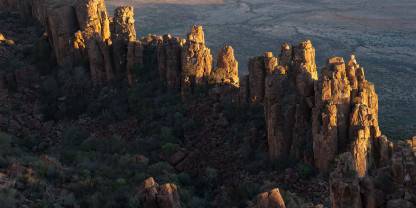
Climate Chart Camdeboo National Park – 751-1,447m / 2,464-4,747ft
Classified as semi-arid to arid, Camdeboo National Park receives an average rainfall of less than 350mm/14in per year. Most of the rain falls between October and April. Midwinter brings temperatures down to freezing. The park’s altitude ranges from 751m to 1,447m (2,464ft to 4,747ft), so even within the park, there are climatic variations. However, the upper reaches are on the inaccessible mountain peaks.
Winter May to September
The winter months experience very low temperatures at night and in the early mornings. It is advisable to bring warm clothes. There is little to no rain, and the skies tend to be clear. Snow can fall, but mainly on the mountain peaks.
- May – This is the start of winter. Temperatures begin to drop to an average of 7°C/45°F in the morning and 21°C/70°F in the afternoon.
- June & July – The temperatures are the coldest during June and July. The average morning temperature is 4°C/39°F, but it sometimes gets well below freezing point at night. Typical daytime temperatures are around 20°C/68°F.
- August & September – Temperatures rise to an average of 22°C/72°F in the afternoon. Morning temperatures increase, with an average of 5°C/41°F.
Summer October to April
Although the summer is mostly sunny, it can be cloudy and there are occasional rainstorms. The temperatures are very comfortable.
- October & November – It warms up. Temperatures range between 10°C/50°F in the morning and 26°C/79°F in the afternoon. Rain is increasing, but it seldom rains for days in a row.
- December, January & February – These are the warmest months with afternoon temperatures reaching upward of 30°C/86°F. Mornings are more pleasant at about 15°C/59°F. Some rain is possible.
- March & April – It once again begins to cool with an average daytime temperature of 26°C/79°F. Mornings are around 12°C/54°F. Rain peaks in March and decreases again in mid-April.

